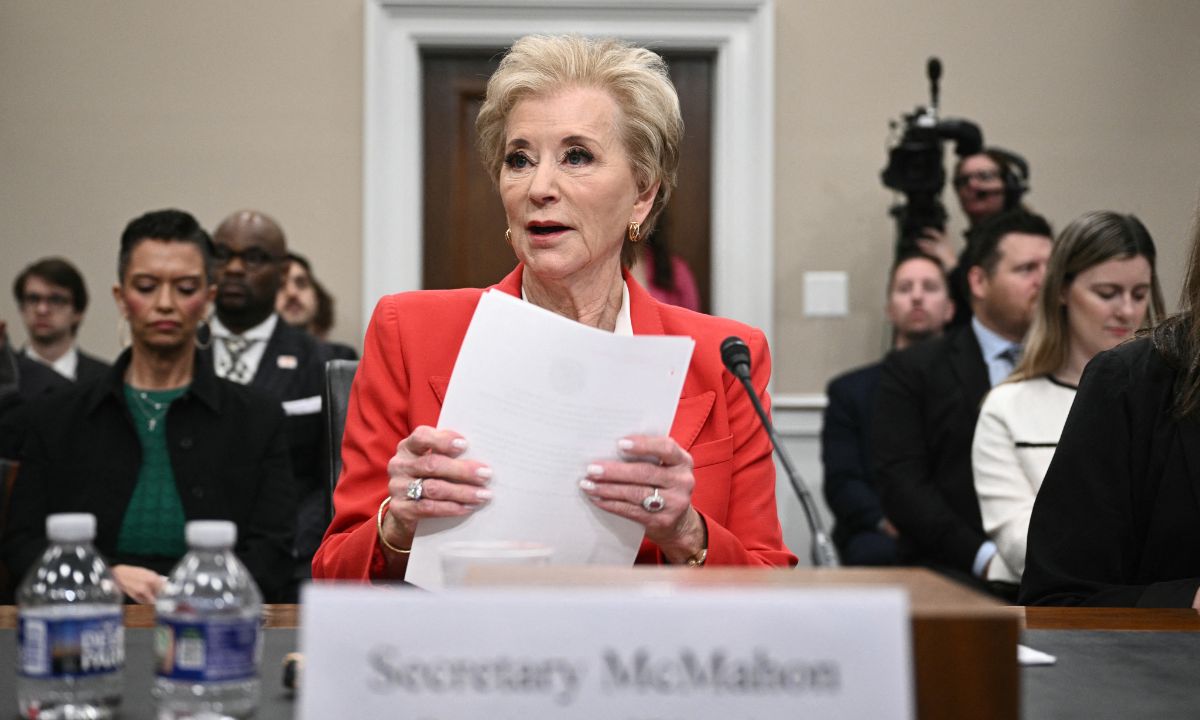Trump, McMahon Claim to Support Education. Funding Cuts Tell a Different Story
Barone: Families deserve a coherent policy that aligns stated goals with the financing and aid to help schools and students attain them.

Get stories like this delivered straight to your inbox. Sign up for The 74 Newsletter
The Trump administration and Secretary of Education Linda McMahon present a troubling paradox regarding the federal role in education. They make public statements that champion educational excellence and evidence-based practices. But, at the same time, they state emphatically that their mission is to dismantle the Department of Education, backing this up with withholding, or proposing to eliminate, funding for policies in areas that they simultaneously claim are of utmost importance.
Nowhere are these contradictions on clearer display than in the department’s proposed priorities for federal competitive grants for evidence-based literacy. On the one hand, the department’s proposed priorities represent the kind of federal leadership that could move the needle on state and local policy in a positive direction. Its commitment to the body of evidence known as the science of reading in particular would help ensure that federal dollars are invested in literacy strategies that are proven to work, rather than ineffective methods that have failed generations of students.
Unfortunately, the administration has moved to eliminate or consolidate programs that support their supposed goals toward evidence-based literacy.
First, President Donald Trump’s Fiscal Year 2026 budget calls for eliminating $194 million in Comprehensive Literacy State Development Grants. This program helps states develop reading instruction for students from birth through high school, emphasizing low-income families, English learners and students with disabilities. The budget also aims to defund the Innovative Approaches to Literacy Grants program.
These are two of 18 programs slated for consolidation into a block grant. While the Trump budget states that a minimum of 7.5% of block grant funds ($150 million) would be reserved for literacy programs, this would still be a 33% cut from existing funding levels for the two programs.
Second, the administration has proposed eliminating $890 million next year from the Title III English Language Acquisition program under the Every Student Succeeds Act and just last week abruptly told states it would not be sending them this year’s funding. Title III provides grants to state education agencies to help English learners become proficient and make academic progress. Eliminating Title III funding — and, for all intents and purposes, repealing the program — would greatly reduce resources and policy guidance that helps English learners. For example, Title III requires states to establish and implement standardized procedures for identifying students who may be English learners and for their eventual exit from that status. If Title III is unfunded, there will be no guarantee that English learners will be assessed and that there will be a clear timeline for their attaining proficiency.
Third, although the proposed priorities on evidence-based reading instruction emphasize the importance of teacher training, the administration has canceled millions of dollars in grants for such programs and will now be withholding about $2 billion in funding for this year under the Title II professional development program. The policies contained in the administration’s proposed literacy priorities could help states emulate the success of places like Mississippi and Louisiana in boosting reading proficiency. However, that’s not going to happen if there is no funding to attach them to.
It is hard to take the administration seriously when it claims to be committed to advancing the science of reading, only to turn around and decimate the very federal programs that would serve that exact purpose. In fact, the department’s stated goal of facilitating a “transition toward closure” makes no sense whatsoever. This position is antithetical to achieving the administration’s stated priorities around the science of reading.
The department is also sending conflicting signals on assessments. On the one hand, the budget contains a great deal of rhetoric about the importance of statewide exams and accountability. On the other hand, it eliminates funding for the State Assessments grant program. The law states that this program must be funded at a level of $361.9 billion, or states will no longer be obligated to administer annual tests. Some observers have taken a “glass half full” approach and pointed to other language in the budget that indicates the department still intends to require states administer assessments. But at the very least, the department is giving states an excuse to opt out and is acting recklessly, given the important role federal law plays as a backstop on assessment and accountability guardrails.
Resolving these contradictions requires an honest acknowledgment of the relationship between educational goals and the means to achieve them. If the department genuinely wants to champion evidence-based instruction, it must support the programs that help educators learn and implement it.
This doesn’t mean that all federal education programs are perfectly designed or optimally effective. There is legitimate room for debate about program structure, funding levels and implementation. But the administration’s approach — maintaining rhetorical support for educational goals while eliminating the programs designed to achieve them — serves neither fiscal responsibility nor educational improvement.
American families deserve better than rhetoric divorced from implementation reality. They need a coherent federal education policy that aligns stated goals with concrete support for helping schools and students attain them. Until the department reconciles the contradictions between what it says and what it funds, its promises of educational improvement will remain empty rhetoric.
Get stories like these delivered straight to your inbox. Sign up for The 74 Newsletter

;)
